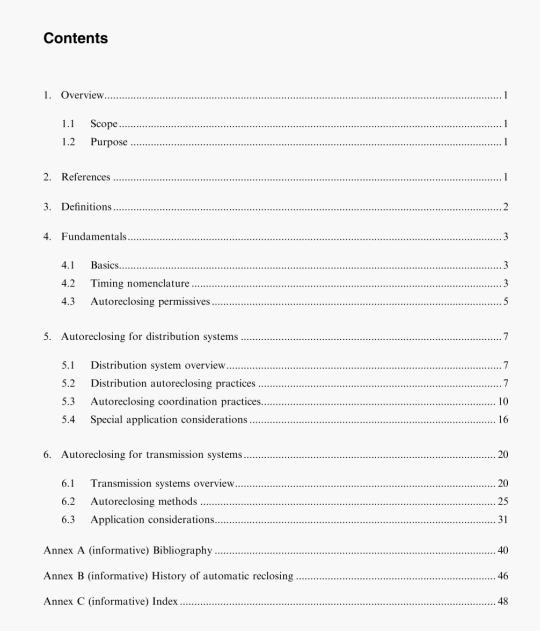IEEE Std C37.104:2002 pdf free download.IEEE Guide for Automatic Reclosing of Line Circuit Breakers for AC Distribution and Transmission Lines.
Figure I includes more detail perhaps than necessary for this description, and is not drawn to scale. The detail shown is to indicate to the rcadcr that there are a number of events that must take place in clearing a fault, some of which need to be considered when dctermining delay settings for the rcclosing relay. Other details, which need to be considered. arc the time required to open and close the controlled breaker, and that the reclosing relay must recognize the position of the breaker by monitoring an auxiliary contact on the mechanism. In some electromechanical relays there is a short delay as the internal logic sets itself for timing. In electronic designs. a short period is allowed to recognize the position of the sending contact (debounce time). While these intervals may be short enough to be neglected in the longer delay settings. they are still a part of the overall sequence of events and may need to be considered when fast autoreclosing is desired. It should also be noted that Figure I is typical and the reader needs to be aware ol’ how the timing functions of the relay are initiated and reset. Care needs to be taken to assure that reset time initiation, cancellation, successful reclosing sequence completion. pausing. and lockout logic are considered. The operation of the relay can vary according to its manufacturer, vintage, and programmed (applied) logic scheme variables.
Figure I illustrates the definitions to be used within this guide relative to the timing of a reclosing relay. The fault clearing sequence begins with the inception of a fault, followed by the controlled breaker being tripped. When the controlled breaker opens. the reclosing relay starts timing toward its initial auioreclosc attempt. At the completion of this delay, the rcclosing relay closes its output contact and initiates breaker closing. At this point, the reclosing relay starts its reset timer. In the illustrated sequence, the fault is not cleared and the protection initiates a second trip. The reset timer is stopped and reset and the reclosing relay begins timing toward a second autoreclosing attempt and initiates closing of the breaker. Since the fault has now been cleared and the breaker remains closed for the interval of the reset delay timer, the reclosing relay resets itself to its initial states.
If the fault persists and the number of programmed autoreclosing attempts expires. the reclosing relay advances to its lockout state, leaving the breaker open. The reclosing relay is now disabled until the breaker is closed by other means. Depending on the design of the reclosing relay, the relay may then reset immediately or alter the reset time delay. In the event that the breaker is manually closed and fails to remain closed, care should be taken in the reclosing circuitry to prevent the reclosing relay from operating.
IEEE Std C37.104:2002 pdf free download
